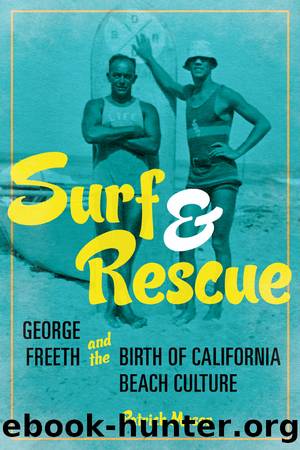Surf and Rescue by Patrick Moser

Author:Patrick Moser [Patrick Moser]
Language: eng
Format: epub
Publisher: University of Illinois Press
Published: 2022-03-15T00:00:00+00:00
8
From Competitor to Mentor
Freeth had the idea in the spring of 1909âin the midst of his woes with the AAUâof traveling to Hawaiâi and recruiting the top swimmers to work as lifeguards in Redondo and play on a professional water polo team. He had a lot of friends among the Healanis and Myrtles, and of course the local boys at WaikÄ«kÄ«. This crew would form the nucleus of a professional water polo league in Southern California and help Freeth accomplish two goals: to raise the level of play in the sport and to avoid any further interference from the AAU.1 Freeth, as we know, never made that trip. He chose rather to return to Los Angeles from San Francisco and back up his charges of professionalism against area athletes.
But after the sensational success of Duke Kahanamoku and Vincent Genoves at the AAU meet in August 1911 (Genoves had won freestyle events in the 220, 440, and the mile), Freeth revisited the idea. He offered to work as the Hawaiiansâ manager and spread the news of Duke's world records. His plan was to enter them in the Southern California Swimming Championships and help secure a spot for the two men in the Olympic tryouts.
Once news spread that Freeth had taken on the role of Duke's âunofficial manager,â however, Honolulu's power brokers moved quickly to block that possibility.2 They saw Duke's Olympic bid as a potential advertising boon for the islands, one that needed careful handling. Duke required a coach who not only understood the âwiles and wrinklesâ of top competition but who also would ensure that the young swimmer didn't violate his amateur status. âFreeth undoubtedly means well by offering to take Duke under his wing,â stated H. M. Ayres, editor at the Hawaiian Star, âbut it is a safe bet that [Duke] would be classed as a professional within a month after his arrival in California. Freeth sees a chance for the native to make a nice piece of money in California aquatics and incidentally an opportunity to profit himself through intelligent exploitation of Duke.â3 Ayres concluded that if Duke were to have any chance of competing in Stockholm, he needed to leave Hawaiâi âunder proper auspices.â The writer suggested that William T. Rawlinsââan old Yale manââwould be the perfect candidate for the coaching position.4 The Ivy League schools had long been a training ground for elite young haole men in the islands, a tradition that stretched back to the original missionaries who sent their male children back to New England for their continuing education. Walter F. Dillingham, for exampleâwhose company Freeth worked for at Pearl Harbor, attended Harvard; his brother-in-law, Walter F. Frear, who attended Yale, was the territorial governor (1907â1913). Hawaiâi was a de facto oligarchy at this time, ruled by a small group of businessmen who shared conservative Protestant values and worked in unison to maintain their influence in all aspects of society. The founder of the Hawaiian Star, Joseph Ballard Atherton (born in Boston, Massachusetts), was
Download
This site does not store any files on its server. We only index and link to content provided by other sites. Please contact the content providers to delete copyright contents if any and email us, we'll remove relevant links or contents immediately.
Down the Drain by Julia Fox(922)
The Light We Carry by Michelle Obama(855)
Cher by Cher(713)
Simple Passion by Annie Ernaux(698)
Love, Pamela by Pamela Anderson(571)
Zen Under Fire by Marianne Elliott(536)
You're That Bitch by Bretman Rock(517)
The Foxfire Book of Appalachian Women by Kami Ahrens(498)
Novelist as a Vocation by Haruki Murakami(497)
Kamala Harris by Chidanand Rajghatta(472)
Alone Together: Sailing Solo to Hawaii and Beyond by Christian Williams(458)
The Nazis Knew My Name by Magda Hellinger & Maya Lee(438)
Gambling Man by Lionel Barber(434)
Drinking Games by Sarah Levy(396)
A Renaissance of Our Own by Rachel E. Cargle(385)
The Barn by Wright Thompson(385)
Memoirs of an Indian Woman by Shudha Mazumdar Geraldine Hancock Forbes(383)
Limitless by Mallory Weggemann(382)
Oh My Mother! by Connie Wang(360)
